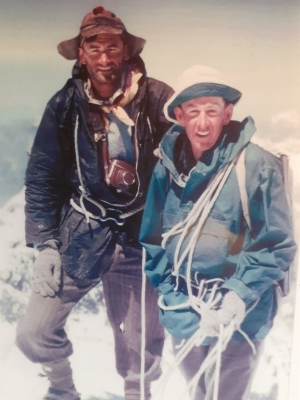Search

 Peter Bain (right)on the summit of Mt Cook. Photo supplied.A man who has travelled extensively to some far-flung corners of the world, Peter still resides in Ashburton. I recently caught up with Peter while he was packing yet again for the next chapter of his life – moving from his home of 49 years.
Peter Bain (right)on the summit of Mt Cook. Photo supplied.A man who has travelled extensively to some far-flung corners of the world, Peter still resides in Ashburton. I recently caught up with Peter while he was packing yet again for the next chapter of his life – moving from his home of 49 years.
Peter grew up on the family farm in Coldstream with dreams of being an explorer after reading about famous explorers. He attended Ashburton High School. By the age of 17 he had branched out into mountaineering after earlier tramping. He and some mates would head off into the Southern Alps for days on end and before Search and Rescue was widely available, they learned to be “self-reliant and careful climbers”. What would these days, be a half hour rescue by helicopter getting an injured climber out of the mountains could, in the 1940s, be a difficult 4 day mission. About this time Peter, and a group of like-minded chaps walked from the Erewhon/Mesopotamia area through the mountains arriving in Whataroa on the West Coast 2 weeks later. Most of Peter’s climbing companions at this time were returned servicemen looking for some much-needed R&R. Peter, being the youngest in the group, soon learned the necessary ‘pecking order’. His responsibilities back then included collecting the firewood and boiling the billy at the end of a day’s climbing.
In 1955 Peter was invited to join a party of climbers with the aim of summiting Mt Masherbrum in Pakistan. Initially bound for India, the group of nine travelled by sea. On the leg from Bombay to Pakistan they were joined by many bound for Mecca. There were three classes of passenger: 1st, 2nd and Pilgrim class. The Pilgrim class were all housed in the hold area of the ship, along with goats and everything else they would need to feed and provide for themselves for their journey which would take them to Jeddah before their pilgrimage towards Mecca.
In Rawal Pindi in the Punjab province of Pakistan, Peter’s group set up their base in military headquarters and were billeted with various regiments in the town. According to Peter, the way of life at that time was “straight out of a Kipling novel”. The party and its four tons of food and gear was flown the exacting route through the Indus Valley by noisy and uncomfortable Bristol freighter. One of their team, Rod Hewitt, who had been a Bomber Command Pilot in WWII had to cover his eyes while the pilot dodged 26,000ft mountains. At Skardu the group arranged porters and the 50 ponies needed to transport all their stores to the foot of the mountain, a hundred mile trek along barren valleys.
On arriving at the foot of the Masherbrum Glacier in mid-May, they found that the “effects of a late and severe winter did not promise a good climbing season, but after a great deal of hard work in soft snow, we established Base Camp at 14,000 feet. From there the route lay up the Serac Glacier, a broken, steep ice-fall from the upper slopes of the mountain. This ice-fall provided us with very interesting but not technically difficult mountaineering, and our route-finding instincts, sharpened by seasons in the Southern Alps, served us well”.
Three months hard but satisfying climbing saw the team miss the summit by a few hundred feet! This was due mostly to the weather which frustrated the climbers day after day. There would be repeated snowfalls during the night and with poor visibility progress was slow and it was not until mid-June that the party was in position on the Dome at 21,000 feet, ready for an attempt on the summit. “The assault and support teams reached a height of just less than 24,000 feet before adverse weather brought about by the onset of the Monsoon compelled the leader, Stanley Conway, to sound the retreat”. The avalanche risk was extremely high and the team lost a porter to altitude sickness. These porters, unlike Sherpas, weren’t used to living and climbing in high altitudes. The party had vowed to the porters that if any porter was lost on the journey, their body would be returned to their home village, a promise that was kept.
According to Peter “we were all a bit lean after two and a half months climbing” but they still had the energy to play a game of polo with “one of the local Rajahs, and we ate our fill of apricots and mulberries, which were by then ripe and very tasty after the rather solid alpine diet”. Peter celebrated his 23rd birthday on the trip.
In 1959 the NZ Government, through the Antarctic Division, invited the NZ Alpine Club on an expedition to the Antarctic to map and study geology in the area Roald Amundsen and Captain Robert Falcon Scott had explored. Intensive training for the three month expedition, Peter’s specialised task was as radio operator. The team of eight covered 20 kms each day with huskies to haul their equipment. The huskies ate seal meat while the mens’ diet was porridge (with butter), biscuits (with butter), dried meat stew (with butter) They were constantly hungry and the diet never changed for 100 days!
Every ten days Peter used the radio to signal by Morse code to Scott Base to let them know the team was alive and well and every few days the radio was used to listen to a radio station in South America which constantly broadcast the time. This was needed by the surveyor to check the time on his watch for the exact time the sun was at its highest in the sky to make the correct calculations for mapping purposes.
The men were accommodated in dark brown tents to assist with sleeping in the 24 hour daylight. Water was very scarce and to obtain it meant using valuable kerosene to melt snow so washing was very low on their priority list, as was dishwashing and so ‘licking the plate clean’ took on a whole new meaning. Peter had worn the same clothes for three months and on his return home, the clothes were burned!
Peter met his future wife Marie, who was a trainee nurse at Ashburton Hospital and they married in 1959. They spent the first four years of their married life on the West Coast where Peter taught at Reefton District High School. Peter began teaching at Ashburton College in 1969 and was in charge of Junior Science and later he really enjoyed his involvement in setting up the Student Learning Support Unit. He coached cricket at Ashburton College for many years. Peter and Marie raised their two sons Alasdair (now in Napier) and Robert who resides in Rangiora while living in Ashburton. Marie passed away in 2004.
Peter was a fine cricketer and after many years involvement wrote ‘The First Century’ a history of the Ashburton County Cricket Association 1896-1996. Peter played cricket until he was 60 and describes himself as a “keen and enthusiastic player”.
In his last 5-6 years at College, Peter took 4th formers (Year 9) into the hills for 3-4 days at a time for outdoor education. He says “they often grizzled but they learned a lot of self-reliance and some valuable skills”.
In 1988 Peter organised the Jubilee Expedition to the Kashmir Himalayas and revisited the area later as a guide for Russell Kelly’s trekking operation. In 1994 Peter returned to the Masherbrum area with a British party, and “did some good climbing and met one of our porters, Mohammed Ali from the 1955 trip”.
Retirement from College at the end of 1990 saw Peter begin his own guided mountaineering business. He took 1-2 clients at a time into his favourite mountain places. An economist client once described Peter’s cooking as a “gross domestic product”!
In 2005 and 2008 Peter climbed in Austria, Italy and Switzerland, including an ascent on the Matterhorn. The Cuillin Mountains on the Isle of Skye were on his list and while there he also carried out some family history research. In 2012 he climbed in the Grand Teton National Park in the Rockies and as recently as 2017 to Cradle Mountain National Park in Tasmania.
As if mountaineering, teaching and cricket weren’t enough feathers in his cap, Peter and Marie also owned and regularly sailed a trailer yacht mostly out of Pigeon Bay. Peter recently sold this and is very happy the new owners are insisting on him continuing on as a crew member!
About 20 years ago, to celebrate the 50th anniversary of the first ascent of Mt Everest, Peter led a group of retired mountaineers, ex high country farmers and enthusiasts of a ‘certain age’ to the top of Mt Somers in mid winter. The group was named ‘The Dog Tucker Club’ referring to sheep well past their best and fit only for feeding the station dogs. They would go 4-5 days each year, stay on back country stations and fill their days with activity appropriate to their physical condition. Fishing, photography, walking, meeting each night and quite possibly partaking of one or two of ‘Essence of Barley’. They even have their own resident bagpiper!
While writing Peter’s profile, my thoughts kept returning to the need for a book to be written to fully cover the extraordinary life of this humble, knowledgeable, accomplished and sage man. I hope that I have captured some of the essence of what makes Peter Bain the remarkable individual he is.
By Shirley Falloon (nee Melrose) © AshColl Alumni - August 2019


